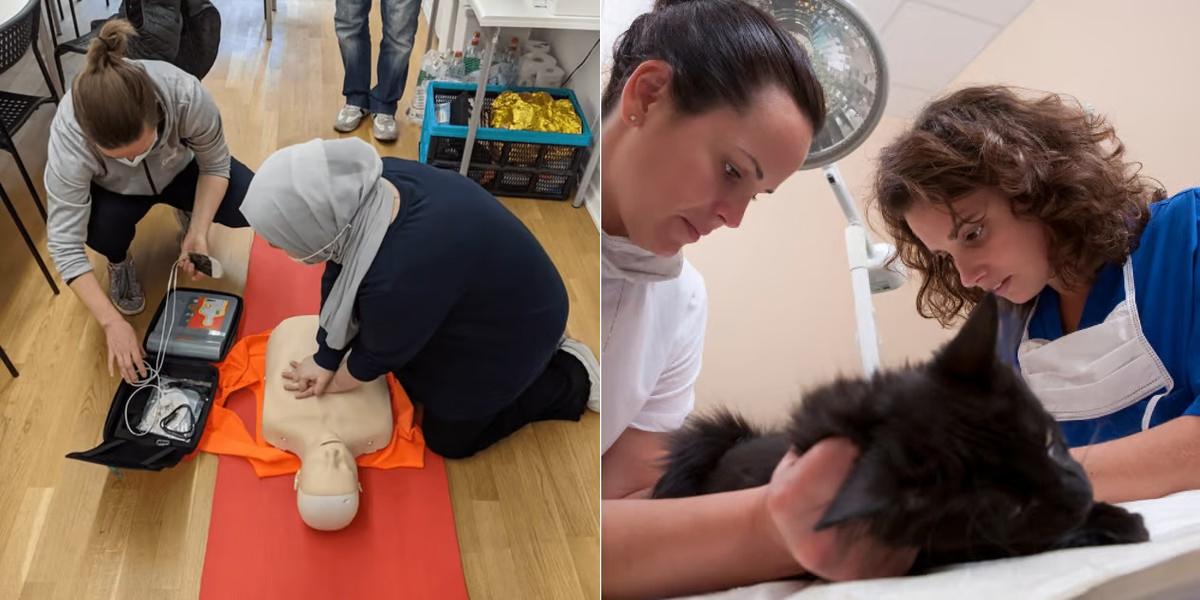CPR-BLS vs Veterinary Assistant

Want personalized recommendations?
Let's match you to the right program

Key Points:
- CPR-BLS focuses on emergency life-saving techniques, while Veterinary Assistants support veterinarians in animal care and treatment.
- CPR-BLS providers may earn more due to the critical nature of their work, while Veterinary Assistants' pay can vary based on location and experience.
- CPR-BLS jobs are available in healthcare settings, while Veterinary Assistant roles are found in animal hospitals and clinics.
- CPR-BLS training is often done in-person, while Veterinary Assistant training can be found both online and in-person.
- CPR-BLS training is typically shorter and less expensive than the education required for Veterinary Assistants.
Vocational training provides individuals with the necessary skills and knowledge to pursue a specific career path. In the animal care industry, two popular vocational training options are CPR-BLS and Veterinary Assistant programs. Both of these paths offer unique opportunities to work with animals and make a positive impact on their health and well-being.
Article continues after recommendations
Recommended for you
What is CPR-BLS and Veterinary Assistant?
-
CPR-BLS (Cardiopulmonary Resuscitation - Basic Life Support): CPR-BLS training focuses on teaching individuals life-saving techniques for responding to medical emergencies. This includes performing CPR, administering first aid, and using automated external defibrillators (AEDs). CPR-BLS certification is often required for healthcare professionals, lifeguards, and individuals working in emergency response roles.
-
Veterinary Assistant: A Veterinary Assistant provides support to veterinarians and veterinary technicians in animal healthcare facilities. Their responsibilities may include assisting with animal examinations, administering medication, collecting samples, maintaining records, and providing basic animal care. Veterinary Assistants play a crucial role in ensuring the well-being of animals under the supervision of a licensed veterinarian.
Difference between CPR-BLS and Veterinary Assistant
While both CPR-BLS and Veterinary Assistant roles involve working with animals, there are several key differences between the two:
-
Focus: CPR-BLS training primarily focuses on emergency medical procedures for humans, while Veterinary Assistant training focuses on animal healthcare and assisting veterinarians in their daily tasks.
-
Scope of Practice: CPR-BLS certified individuals are trained to respond to medical emergencies and provide life-saving interventions. Veterinary Assistants, on the other hand, work under the supervision of veterinarians and are responsible for providing general care and support to animals.
-
Certification Requirements: CPR-BLS certification is often required for specific professions such as healthcare providers and lifeguards. Veterinary Assistant certification is not always mandatory, but it can enhance job prospects and demonstrate a commitment to the field.
-
Career Path: CPR-BLS training can lead to careers in healthcare, emergency response, or other related fields. Veterinary Assistants can pursue further education and training to become Veterinary Technicians or even veterinarians.
CPR-BLS vs Veterinary Assistant: Job Description
-
CPR-BLS: Professionals with CPR-BLS certification are equipped to respond to medical emergencies and provide life-saving interventions. They may work in hospitals, clinics, emergency medical services, or other healthcare settings. Responsibilities may include performing CPR, assisting with advanced cardiac life support (ACLS), and providing basic first aid.
-
Veterinary Assistant: Veterinary Assistants provide support to veterinarians and veterinary technicians in animal healthcare facilities. Their duties may include restraining animals during examinations, assisting with surgeries, administering medication, collecting samples, and maintaining records. They may also be responsible for providing basic animal care, such as feeding and grooming.
CPR-BLS vs Veterinary Assistant: Education and Training
-
CPR-BLS: CPR-BLS training programs are typically short-term, ranging from a few hours to a few days. These programs cover topics such as CPR techniques, basic life support, automated external defibrillator (AED) use, and first aid. Certification is generally obtained through successful completion of a written exam and demonstration of practical skills.
-
Veterinary Assistant: Education and training requirements for Veterinary Assistants can vary. Some states require formal education, while others may accept on-the-job training or a combination of both. Formal programs are typically offered at community colleges or vocational schools and can range from a few months to a year. Coursework may cover topics such as animal anatomy, medical terminology, animal care, and veterinary office procedures.
Get courses selected just for you
Try our powerful search engine
Article continues after recommendations
More recommendations for you
CPR-BLS vs Veterinary Assistant: Career Outlook and Salary
-
CPR-BLS: The demand for healthcare professionals with CPR-BLS certification is expected to remain high. Job opportunities can be found in hospitals, clinics, emergency medical services, and other healthcare settings. According to the Bureau of Labor Statistics, the median annual wage for healthcare support occupations, including CPR-BLS certified professionals, was $29,740 in May 2020.
-
Veterinary Assistant: The employment outlook for Veterinary Assistants is also promising. As the pet industry continues to grow, the demand for animal healthcare services is expected to increase. Veterinary Assistants can find employment in veterinary clinics, animal hospitals, research facilities, and animal shelters. According to the Bureau of Labor Statistics, the median annual wage for veterinary assistants and laboratory animal caretakers was $28,590 in May 2020.
Final Thoughts
Both CPR-BLS and Veterinary Assistant training paths offer unique opportunities to work with animals and make a positive impact on their health and well-being. While CPR-BLS certification focuses on emergency medical procedures for humans, Veterinary Assistant training provides individuals with the skills and knowledge to provide general care and support to animals. Ultimately, the choice between these two paths depends on an individual's interests, career goals, and passion for either human or animal healthcare.
Ensuring accessibility for individuals seeking growth, Dreambound strategically places its educational programs in various locations. Delve into a more comprehensive understanding of the exciting opportunities within these two vocations by visiting: -CPR-BLS in Texas -Veterinary Assistant in Texas -CPR-BLS classes near you

Athena is Co-founder and CEO of Dreambound.



